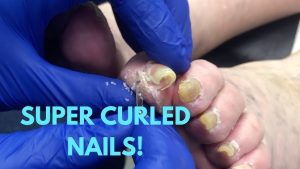LIFTED NAIL AND A LITTLE RAM’S HORN!
Read Full Detail and link video down here

1. Clearing a Lifted Nail:
A lifted nail can happen when the nail is no longer securely attached to the nail bed, often due to trauma, poor nail care, or improper acrylic or gel application. Here’s how to clear it up:
-
Assess the damage: If the nail is only slightly lifted, it’s possible to care for it at home. However, if it’s painful, infected, or severely lifted, you may need to visit a professional.
-
Trim and File: If the nail is partially detached, gently trim it and file it down to prevent snagging or further lifting.
-
Clean the Area: Keep the lifted area clean and dry. Use mild soap and water, and avoid getting water trapped under the lifted part. You can use a cotton swab to gently clean the area.
-
Protect: If there is a risk of infection or further damage, you might want to apply a topical antibiotic ointment (like Neosporin) to the area and bandage it to prevent dirt from getting in.
-
Nail Repair: If you’re doing DIY repairs, you can use a nail glue or resin to reattach the lifted part temporarily, but it’s best to have a professional handle it if you’re unsure.
-
Avoid Further Damage: Be careful with how you treat the nail during the healing process. Refrain from picking or pulling on it, as this can cause more damage.
2. Clearing the Little Ram’s Horn (Nail Art):
If you’re talking about removing a little ram’s horn design from your nails (whether it’s an actual curled shape or a nail art design), here’s how you can remove it:
-
Soak in Acetone: If it’s a design made with gel polish, the best way to remove it is by soaking a cotton ball in acetone, wrapping it around your nails, and allowing it to sit for 10-15 minutes. Afterward, gently scrape the design off with an orangewood stick or a cuticle pusher.
-
Use Nail Polish Remover for Regular Polish: If it’s just regular nail polish, dip a cotton pad in nail polish remover and hold it on your nails for 1-2 minutes to loosen the polish. Then gently wipe it off.
-
File It Off: If you’re trying to remove a raised nail art design like a “ram’s horn” shape that’s built up, you can file the surface down gently with a fine-grit nail file. Be careful not to file too hard to avoid damaging your natural nail.
General Tips:
-
Be Gentle: Whether you’re dealing with a lifted nail or removing a design, be gentle to avoid causing more harm to your nails.
-
Consult a Professional: If you’re unsure or dealing with a painful, infected, or badly lifted nail, it’s best to consult with a nail technician or dermatologist.
A super thick toenail can sometimes be caused by a variety of things like fungal infections, injury, or a condition like onychauxis (which is when nails thicken due to pressure or trauma). It can also happen from wearing tight shoes or poor nail care. The good news is, there are ways to manage and treat it! Here’s how to fix a thick toenail:
1. Assess the Cause
First, determine if there’s an underlying issue causing the thick toenail:
- Fungal Infection: This can lead to thickening, discoloration, and crumbling of the toenail.
- Trauma: Injury to the toenail can cause it to thicken or grow abnormally.
- Pressure from Tight Footwear: Continuous pressure from tight shoes can cause thickening.
- Other Health Conditions: Conditions like psoriasis or poor circulation can also affect nail thickness.
If you’re unsure of the cause, it’s best to visit a podiatrist to get an accurate diagnosis.
2. Treat a Fungal Infection (If Applicable)
If the thick toenail is caused by a fungal infection, you’ll need to treat it with antifungal medication. Over-the-counter treatments are available, but if the infection is severe, a doctor may prescribe oral antifungal medication.
- Over-the-Counter Treatments: Creams, ointments, and nail lacquers like Lamisil or Lotrimin can be applied to the nail. It can take several weeks to months to see improvement, so consistency is key.
- Prescription Treatment: For persistent or severe fungal infections, a podiatrist might prescribe stronger treatments or even recommend laser therapy.
3. Trim the Toenail Carefully
Trimming a thick toenail can help manage the thickness and prevent it from growing too long or becoming painful. But be careful to avoid causing damage to the nail or surrounding skin:
- Soften the Nail: Soak your feet in warm water for about 10-15 minutes to soften the toenail. You can add Epsom salt for added relief.
- Trim Gradually: Use a pair of nail clippers designed for thick nails (they are usually larger and stronger). Trim a little at a time to avoid cutting too much.
- File: After trimming, use a nail file to smooth out the edges of the toenail. Be gentle to avoid hurting the skin around it.
4. File the Nail Down (for Non-Fungal Thickening)
If the toenail is thick due to pressure, injury, or another non-fungal cause, you can try filing it down:
- Use a Coarse File: A coarse nail file or electric nail file can be used to carefully file down the thick toenail. Be gentle to avoid damaging the nail or causing pain.
- File Slowly: Take your time to avoid filing too aggressively. After filing, smooth the edges with a finer nail file.
5. Moisturize the Toenail
Thick toenails can become brittle and dry, leading to more issues. Apply a thick, hydrating cream (like Urea-based creams or petroleum jelly) to your toenail to keep it moisturized.
6. Wear Proper-Fitting Shoes
Ensure that your shoes are not putting extra pressure on your toenails. Opt for shoes with a wide toe box and avoid tight shoes, especially if you’re prone to thick toenails.
7. Regular Foot Care
Keep up with regular foot care to prevent further thickening:
- Trim Toenails Regularly: Keep them at a manageable length.
- Clean and Dry Feet: Make sure your feet are clean and dry to avoid fungal growth.
- Monitor Nail Health: Keep an eye on any changes in the toenail’s color or texture.
8. Consult a Podiatrist
If your toenail is extremely thick, painful, or showing signs of infection (like redness, pus, or a foul smell), it’s important to see a podiatrist or dermatologist. They can offer professional treatments, including:
- Debridement: A podiatrist can safely trim or thin down the nail.
- Prescription Treatments: For fungal infections or severe cases.
Additional Tips:
- Avoid Self-Diagnosis: If the toenail is thick and you’re unsure of the cause, seek medical advice to ensure proper treatment.
- Take Care of Your Feet: Regular foot care and hygiene can prevent thick toenails from becoming an ongoing issue.


